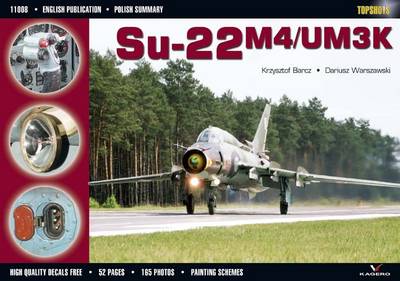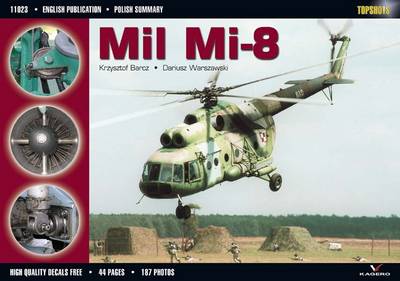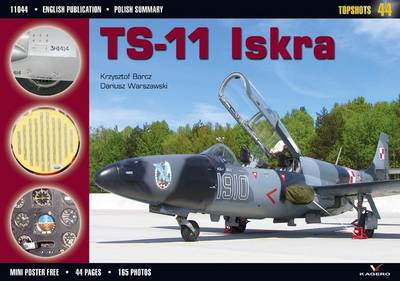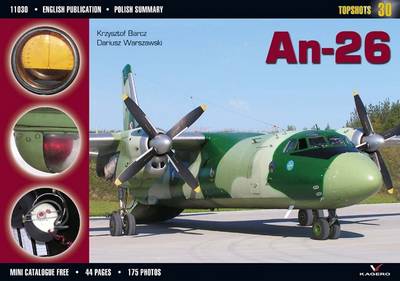Topshots
8 total works
The SU22 M4 is still widely used in Europe and the Middle East, being broadly compatible to a Tornado GR1 although lacking the latter’s all-weather capability. Like the Tornado it is equipped with a laser range finder designator and terrain following radar and could be equipped with bombs, guided missiles and rockets in addition to the installed twin 30mm canon for the air to surface attack role. Air-to-air threats were countered via rockets, guided missiles and canon.
This is a Monograph on this supersonic fighter bomber, containing 165 photos, including numerous colour photos with English/Polish photo captions, featuring external and internal views, and 3 colour profiles. Includes a free decal sheet.
About the Series
This is a classic series of highly illustrated books on the best machines of war, with several hundred photographs of each aircraft or vehicle. With close-up views of the key features of each machine, including its variations, markings and modifications, customising and creating a model has never been easier. Includes extra features such as decals and masking foil.
The many superb detailed photographs in this monograph makes this an ideal publication for the modeller and enthusiast alike.
About the Series
This is a classic series of highly illustrated books on the best machines of war, with several hundred photographs of each aircraft or vehicle. With close-up views of the key features of each machine, including its variations, markings and modifications, customising and creating a model has never been easier. Includes extra features such as decals and masking foil.
The Hawk T1 was the original version of the Hawk used by the RAF, deliveries commencing in November 1976. The UK ordered 176 T1s.
This book is an invaluable album of detailed photographs for the modeller.
About the Series
This is a classic series of highly illustrated books on the best machines of war, with several hundred photographs of each aircraft or vehicle. With close-up views of the key features of each machine, including its variations, markings and modifications, customising and creating a model has never been easier. Includes extra features such as decals and masking foil.
The JAS 39C is the NATO-compatible version of Gripen with extended capabilities in terms of armament, electronics, etc. This variant can also be refuelled in flight.
The JAS 39D is the two-seat version of the C variant.
This album of detailed photographs is invaluable for the modeller or enthusiast alike.
About the Series
This is a classic series of highly illustrated books on the best machines of war, with several hundred photographs of each aircraft or vehicle. With close-up views of the key features of each machine, including its variations, markings and modifications, customising and creating a model has never been easier. Includes extra features such as decals and masking foil.
The TS-11 Iskra is an all-metal jet trainer plane, conventional in layout. Its wings are trapezoid-shaped, with the leading edge swept at small angle. The single jet engine has an exhaust under a boom with tail fin, which gives the plane an unusual silhouette. The two crewmen have ejector seats. The aircraft has no radar (apart from the TS-11R), but it can be fitted with photo cameras.
This album of detailed photographs is invaluable for the modeller or enthusiast alike.
About the Series
This is a classic series of highly illustrated books on the best machines of war, with several hundred photographs of each aircraft or vehicle. With close-up views of the key features of each machine, including its variations, markings and modifications, customising and creating a model has never been easier. Includes extra features such as decals and masking foil.
Developed and built by Panavia, the Tornado first flew on 14 August, 1974, and saw action with the RAF, AMI (Italian Air Force) and Royal Saudi Air Force in the Gulf War. International co-operation continued after its entry into service within the Tri-National Tornado Training Establishment, a tri-nation training and evaluation unit operating from RAF Cottesmore, England. Including all variants, 992 aircraft were built for the three partner nations and Saudi Arabia.
This Monograph on this European fighter bomber contains 118 colour photos, with English/Polish photo captions, featuring external and internal views, and 3 colour profiles. Also included is a free decal sheet and high quality masking foil.
About the Series
This is a classic series of highly illustrated books on the best machines of war, with several hundred photographs of each aircraft or vehicle. With close-up views of the key features of each machine, including its variations, markings and modifications, customising and creating a model has never been easier. Includes extra features such as decals and masking foil.
The core of the aircraft was derived from the Mil Mi-8. Original versions have an angular greenhouse-style cockpit; Model D and later have a characteristic tandem cockpit with a"double bubble" canopy. The body is heavily armoured and can resist impacts from .50 caliber (12.7 mm) rounds from all angles, including the titanium rotor blades. The cockpit is an even more heavily armoured titanium tub and can resist impact from 37mm cannon rounds.
Considerable attention was given to making the Mi-24 fast. The airframe was streamlined, and fitted with retractable tricycle undercarriage landing gear to reduce drag. The wings provide considerable lift at high speed, up to a quarter of total lift.
This Monograph covers this assault helicopter. Included are 145 colour photos, many of them close-ups, featuring markings and codes, and Techmod decals to cover 3 aircraft in 1:72, 1:48 and 1:35 scales, making this an ideal publication for the modeller.
About the Series
This is a classic series of highly illustrated books on the best machines of war, with several hundred photographs of each aircraft or vehicle. With close-up views of the key features of each machine, including its variations, markings and modifications, customising and creating a model has never been easier. Includes extra features such as decals and masking foil.
Using the majority of the An-24 airframe, with its high-set cantilevered wings, twin turboprops and stalky main undercarriage, the An-26 included military equipment, such as tip-up paratroop canvas seats, overhead traveling hoist, bulged observation windows and parachute static line attachment cables.
About the Series
This is a classic series of highly illustrated books on the best machines of war, with several hundred photographs of each aircraft or vehicle. With close-up views of the key features of each machine, including its variations, markings and modifications, customising and creating a model has never been easier. Includes extra features such as decals and masking foil.






